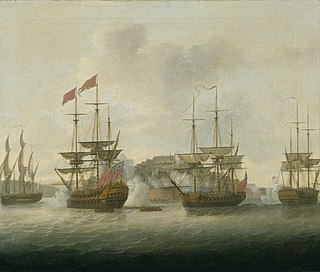
Colonia del Sacramento is a city in southwestern Uruguay, by the Río de la Plata, facing Buenos Aires, Argentina. It is one of the oldest towns in Uruguay and the capital of the Colonia Department. It has a population of around 27,000.

The Viceroyalty of the Río de la Plata meaning "River of the Silver", also called "Viceroyalty of the River Plate" in some scholarly writings, in southern South America, was the last to be organized and also the shortest-lived of the Viceroyalties of the Spanish Empire in the Americas. The name "Provincias del Río de la Plata" was formally adopted in 1810 during the Cortes of Cádiz to designate the Viceroyalty of the Río de la Plata.

The Governorate of the Río de la Plata (1549−1776) was one of the governorates of the Spanish Empire. It was created in 1549 by Spain in the area around the Río de la Plata.

The British invasions of the River Plate were two unsuccessful British attempts to seize control of the Spanish colony of the Viceroyalty of the Río de la Plata, located around the Río de la Plata in South America – in present-day Argentina and Uruguay. The invasions took place between 1806 and 1807, as part of the Napoleonic Wars, at a time when Spain was an ally of Napoleonic France. In Argentine historiography, the two successive defeats of the British expeditionary forces are known collectively as the "Reconquista" and the "Defensa", respectively.

The Treaty of Madrid was an agreement concluded between Spain and Portugal on 13 January 1750. In an effort to end decades of conflict in the region of present-day Uruguay, the treaty established detailed territorial boundaries between Portuguese Brazil and the Spanish colonial territories to the south and west. Portugal also recognized Spain's claim to the Philippines while Spain acceded to the westward expansion of Brazil. The treaty included a mutual guarantee of support in case either state's American colonies were attacked by a third power.
Banda Oriental, or more fully Banda Oriental del Uruguay, was the name of the South American territories east of the Uruguay River and north of Río de la Plata that comprise the modern nation of Uruguay, the modern state of Rio Grande do Sul, Brazil, and part of the modern state of Santa Catarina, Brazil. It was the easternmost territory of the Viceroyalty of the Río de la Plata.

The Cisplatine War, also known as the Argentine-Brazilian War or, in Argentine and Uruguayan historiography, as the Brazil War, the War against the Empire of Brazil, or the Liberating Crusade in Uruguay, was an armed conflict in the 1820s between the United Provinces of the Río de la Plata and the Empire of Brazil over Brazil's Cisplatina province, in the aftermath of the United Provinces' and Brazil's independence from Spain and Portugal respectively. It resulted in the independence of Cisplatina as the Oriental Republic of Uruguay.

The First Treaty of San Ildefonso was signed on 1 October 1777 between Spain and Portugal. It settled long-running territorial disputes between the two kingdoms' possessions in South America, primarily in the Río de la Plata region.

The Treaty of El Pardo signed on 11 March 1778 sought to end conflict between Spain and Portugal in the Río de la Plata region, along the modern boundary between Argentina and Uruguay. It confirmed Spanish ownership of Colonia del Sacramento, now in Uruguay, while Portugal ceded possession of strategically important territories in Africa, now the modern state of Equatorial Guinea. In return, Spain withdrew from lands to the north, most of which are in the southern Brazilian state of Rio Grande do Sul.

Bruno Mauricio de Zabala y Gortázar (1682–1736) was a Spanish soldier and colonial administrator who served as governor of the Governorate of the Río de la Plata from 1717 to 1734 and founded the city of Montevideo, capital of present-day Uruguay.

Brazil–Uruguay relations encompass many complex relations over the span of three centuries, beginning in 1680 with the establishment of the Colónia do Sacramento, to the present day, between the Federative Republic of Brazil and the Oriental Republic of Uruguay. Brazil and Uruguay are neighbouring countries in South America, and share close political, economic and cultural ties. The singularity of the bilateral relationship between the two countries originates from a strong historical connection, as both countries having been territories of the Portuguese Empire and sharing the same language – marked by important events, such as the establishment of the Colónia do Sacramento in 1680, the invasion of the Banda Oriental by Brazil in 1815 and the subsequent creation of the Província Cisplatina, and Uruguay's independence from Brazil in 1828. The bilateral relationship was further defined by the Uruguayan Civil War (1839–1851) and the Paraguayan War (1864–1870).

The First Cevallos expedition was a series of Spanish military operations in South America during the Fantastic War. Under the command of the governor of Buenos Aires, Pedro Antonio de Cevallos, the expedition captured the Portuguese settlement of Colónia do Sacramento and fought off a joint Anglo-Portuguese attempt to recapture it. All military activities in the region concluded with the 1763 Treaty of Paris.
The Spanish-Portuguese War, also known as the Second Cevallos expedition, was fought between 1776 and 1777 over the border between Spanish and Portuguese South America.

The Portuguese conquest of the Banda Oriental was the armed-conflict that took place between 1816 and 1820 in the Banda Oriental, for control of what today comprises the whole of the Republic of Uruguay, the northern part of the Argentine Mesopotamia and southern Brazil. The four-year armed-conflict resulted in the annexation of the Banda Oriental into the United Kingdom of Portugal, Brazil and the Algarves as the Brazilian province of Cisplatina.

José Joaquín de Viana (1718–1773) was a Spanish military and political figure, Governor of Montevideo between 1751 and 1764 and 1771 and 1773.

The dissolution of the Viceroyalty of the Río de la Plata meant the breakup of the Spanish colony in South America and the creation of new independent countries. Most of the territory of the Spanish viceroyalty is now part of Argentina, and other regions belong to Bolivia, Brazil, Paraguay and Uruguay.

The Portuguese invasion of the Banda Oriental was a short-lived and failed attempt, beginning in 1811 and ending the following year, by the Portuguese Empire to annex the remaining territory of the Spanish Viceroyalty of the Río de la Plata.

Portugal–Uruguay relations refers to the current and historical relations between Portugal and Uruguay. Both nations are members of the Organization of Ibero-American States and the United Nations.

The battle of Colonia del Sacramento consisted of a series of failed attempts made by admiral William Brown of capturing the town of Colonia del Sacramento, which was under Brazilian control and being sieged on land by insurgent Uruguayan forces, in the context of the Cisplatine War between the Empire of Brazil and the United Provinces of the Río de la Plata. The confrontations began in the morning of 26 February 1826 and ended on 14 March 1826.

The siege of Colonia del Sacramento took place between October 1735 and September 1737, during the Spanish–Portuguese War (1735–1737).

















